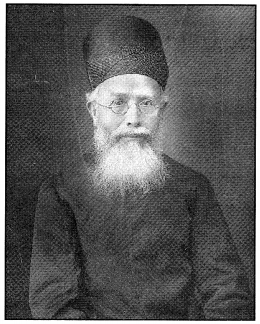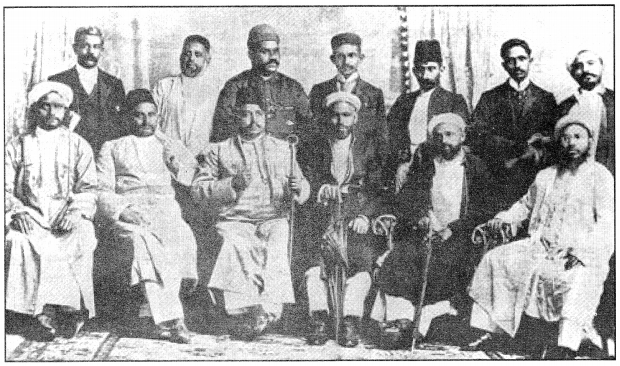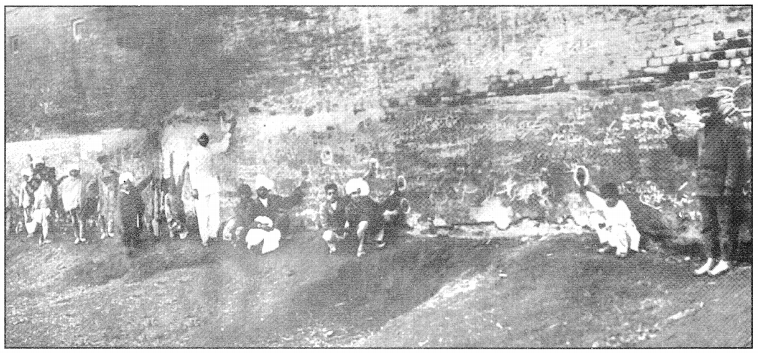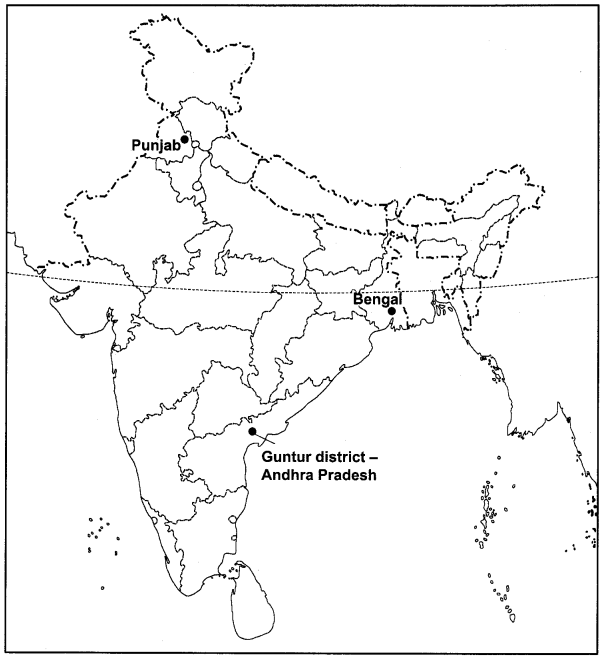CBSE CLASS 10 BOARD 2024 ALL IMPORTANT QUESTIONS

class6,class7,class8,class9,class10,class11,class12,government jobs news,cbse update news,jobs,competition exams,india news,news update,tech news,health news,mcq questions,question answer in hindi ,question answer in english,short answer type questions,very short answer type questions,product reviews,current affairs update news ,travel blog ,education news ,govt vacancy,competition exams notification,saraswati tuition centre,exam notes,maths concept,reasoning ,exam syllabus,ncert ,practice paper

Choose the correct answer:
Question 1.
Marathi newspaper ‘Kesari’ was edited by
(a) Lala Lajpat Rai
(b) Balgangadhar Tilak
(c) Chitta Ranjan Das
(d) Sarojini Naidu
Answer: (b) Balgangadhar Tilak
Question 2.
Lala Lajpat Rai was a nationalist from
(a) Bengal
(b) Bihar
(c) Punjab
(d) Haryana
Answer: (c) Punjab
Question 3.
Which of the following movement is associated with Chitta Ranjan Das?
(a) Quit India Movement
(b) The Salt March
(c) Non-Cooperation Movement
(d) None of these
Answer: (c) Non-Cooperation Movement
Question 4.
The founder of Khudai Khidmatgars was
(a) Mohammad Ali
(b) Shaukat Ali
(c) Badshah Khan
(d) None of these
Answer: (c) Badshah Khan
Question 5.
Who established Natal Congress?
(a) Jawaharlal Nehru
(b) Mahatma Gandhi
(c) Balgangadhar Tilak
(d) Lala Lajpat Rai
Answer: (b) Mahatma Gandhi
Question 6.
Bengal was divided by the British in the year
(a) 1900
(b) 1910
(c) 1905
(d) 1920
Answer: (c) 1905
Question 7.
Hindustan Socialist Republic Association was related with the nationalist
(a) Lala Lajpat Rai
(b) Balgangadhar Tilak
(c) Bhagat Singh
(d) None of these
Answer: (c) Bhagat Singh
Question 8.
The Vernacular Press Act was enacted in
(a) 1840
(b) 1857
(c) 1878
(d) 1890
Answer: (c) 1878
Question 9.
Ilbert Bill was introduced in
(a) 1860
(b) 1878
(c) 1883
(d) 1890
Answer: (c) 1883
Question 10.
Naoroji was ……………….. settled in London.
(a) a businessman and publicist
(b) an artist
(c) an educationist
(d) none of these
Answer: (a) a businessman and publicist
Question 11.
Second World War ended in
(a) 1910
(b) 1920
(c) 1945
(d) 1947
Answer: (c) 1945
Question 12.
The fight for Purna Swaraj was fought under the presidentship of
(a) Mahatma Gandhi
(b) Jawaharlal Nehru
(c) C. Rajagopalachari
(d) Sardar Vallabhbhai Patel
Answer: (b) Jawaharlal Nehru
Question 13.
Who was the first Indian Governor-General of free India?
(a) Mahatma Gandhi
(b) Jawaharlal Nehru
(c) C. Rajagopalachari
(d) Sardar Vallabhbhai Patel
Answer: (c) C. Rajagopalachari
Match the following:
| Column A | Column B |
| (i) Knighthood | (a) The religious functionaries of Sikh gurudwaras |
| (ii) Picket | (b) The capacity to act independently without interference from outside |
| (iii) Mahants | (c) The protest of the people outside a building to prevent others /owners from entering it |
| (iv) Publicist | (d) An honour granted by the British Crown for exceptional personal achievement |
| (v) Provincial autonomy | (e) A person who publishes an idea by circulating information, writing reports and speaking at meetings |
| (vi) Sovereign | (f) A capacity of the province to make relatively independent decisions while remaining within the federation |
Answer:
| Column A | Column B |
| (i) Knighthood | (d) An honour granted by the British Crown for exceptional personal achievement |
| (ii) Picket | (c) The protest of the people outside a building to prevent others /owners from entering it |
| (iii) Mahants | (a) The religious functionaries of Sikh gurudwaras |
| (iv) Publicist | (e) A person who publishes an idea by circulating information, writing reports and speaking at meetings |
| (v) Provincial autonomy | (f) A capacity of the province to make relatively independent decisions while remaining within the federation |
| (vi) Sovereign | (b) The capacity to act independently without interference from outside |
State whether true or false:
1. People were satisfied with British rule in the 1870s and 1880s.
Answer: False
2. The Arms Act was passed in 1875.
Answer: False
3. A.O. Hume was a Chinese educationist.
Answer: False
4. Muslim League demanded “Independent States” for Muslims in 1940.
Answer: True
5. The Congress in the first twenty years of its formation was “moderate”.
Answer: True
6. In 1930, Gandhiji led a march to break the salt law.
Answer: True
7. The leaders of Khilafat agitation were Mohammad Ali and Shaukat Ali.
Answer: True
Fill in the blanks:
1. The Arms Act ……………… Indians from having arms.
Answer: disallowed
2. Gandhiji and his followers marched from ……………… to Dandi.
Answer: Sabarmati
3. 16 August 1946 was announced as ……………… by the Muslim League.
Answer: “Direct Action Day”
4. ……………… is popularly known as Rajaji.
Answer: C. Rajagopalachari
Question 1.
What were the crucial questions asked by the people about India?
Answer:
The crucial questions were: What is this country of India and whom is it meant for?
Question 2.
What is the literal meaning of “Sarvajanik”?
Answer:
The literal meaning of Sarvajanik is “of or for all the people” i.e. Sarva = all + Janik = of the people.
Question 3.
Define the term Sovereign.
Answer:
The capacity to act independently without outside interference.
Question 4.
What was the role played by AO. Hume?
Answer:
A retired British official A.O. Hume played an important role by bringing Indians from the various regions together.
Question 5.
Which movement demanded for Indianisation of the movement?
Answer:
It was part of movement against racism.
Question 6.
What were the means of spreading awareness adopted by the Moderates?
Answer:
The Moderates published newspapers wrote articles for spreading awareness.
Question 7.
Mention the slogan raised by Tilak.
Answer:
Tilak raised the slogan “Freedom is my birthright and I shall have it!”
Question 8.
How was the first year spent by Mahatma Gandhi in India?
Answer:
His first year in India was spent travelling throughout the country, understanding the people, their needs and situations.
Question 9.
What was mainly discussed in the Naoroji’s book Poverty and un-British Rule in Indial
Answer:
In this book, he offered a scathing criticism of the economic impact of British rule.
Question 10.
In which year congress split took place?
Answer:
In 1907.
Question 11.
When did Gandhiji arrived from where?
Answer:
He arrived in 1915 from South Africa.
Question 12.
When was the Khilafat issue got introduced in front of the world?
Answer:
In 1920 Khilafat issue got in front of the world.
Question 13.
Which state of India witnessed Akali Agitation of Sikhs?
Answer:
Punjab.
Question 14.
How did Gandhiji spent his 1st year in India?
Answer:
Mahatma Gandhi spent 1st year in India by traveling throughout the country.
Question 15.
Which dates is observed as a day of non-violent opposition to the Rowlatt Act?
Answer:
6 April 1919.
Question 16.
How many delegates from all over India met at Bombay in 1885?
Answer:
72 delegates.
Question 17.
What is meant by the concept of Poorna Swaraj?
Answer:
It means complete independence.
Question 18.
What does RSS stands for?
Answer:
It stands for Rashtriya Swayam Sevak Sangh.
Question 19.
What was the demand of ‘Assam tea garden labours?
Answer:
The demand was for the increase in the wages.
Question 20.
What does CPI stands for?
Answer:
CPI stands for Communist Party of India.
Question 1.
Describe the event of Gandhiji’s arrival to India from South Africa.
Answer:
Gandhiji, at the age of 46, arrived in India in 1915 from South Africa. He led Indians in South Africa in non-violent marches against racist restrictions. He was already a respected leader known internationally. His South African campaign brought him in contact with various types of Indians.
Question 2.
How did the First World War alter the economic and political situation in India?
Answer:
The First world War led to a huge rise in the defence expenditure of the Government of India. The Government in turn increased taxes on individual incomes and business profits. Increased military expenditure and the demands for war supplies led to a sharp rise in prices that created difficulties for the common people. On other side business groups reaped fabulous profits from the war.
The war created demand for industrial goods and there was seen a decline of imports from other countries into India so Indian industries expanded during the war. These industries began demanding greater opportunities for development. All this shows the way economic and political situation altered in India with the event of the First World War.
Question 3.
Mention the events by which people linked Non-Cooperation movement to local grievances. Answer:
In Kheda, Gujarat, patidar peasants organized non-violent campaigns against the high land revenue demand of the British. In coastal Andhra and interior Tamil Nadu, liquor shops were picketed. In Guntur, tribals and some peasants staged a number of ‘forest satyagrahas’. In Sind, Muslims traders and peasants enthusiastically took part in khilafat call. In Bengal too, there was seen a great communal unity.
Question 4.
What had happened in Chauri Chaura that Gandhiji called off his Non-Cooperation movement?
Answer:
Mahatma Gandhi was against violence. He abruptly called off the Non-Cooperation movement in February. 1922 when a crowd of peasants set fire to a police station in Chauri Chaura. 22 policemen were killed. The peasants were provoked because the police had fired on their peaceful demonstration.
Question 5.
Name the important political associations formed after 1850 especially those who came into being in the 1870’ 80’s and who led them?
Answer:
Most of the political associations were led by the English-educated professionals such as lawyers. The important associations were Poona Sarvajanik Sabha, the Bombay Presidency Association, the Indian National Congress.
Question 6.
Define the terms sovereign, Publicists and Repeal.
Answer:
Question 1.
How did the Non-cooperation Movement gain momentum through 1921-22? Explain.
Answer:
The Non-Cooperation Movement gained momentum through 1921 – 22. Thousands of students left the schools and colleges that were controlled by the government. Many lawyers such as Motilal Nehru, C.R. Das, C.Rajagopalachari and Asaf Ali gave up their practices. British titles that were awarded to several of the Indians were surrendered.
Legislatures were boycotted. People lit public bonfires of foreign cloth. The import of foreign cloth fell drastically between 1920 and 1922. But all this was seen as merely the tip of the iceberg. The large parts of the country were on the brink of a formidable revolt.
Question 2.
What was the process adopted by revolutionary nationalists such as Bhagat Singh and his comrades for fighting colonial rule and the rich exploiting classes?
Answer:
Revolutionary nationalists such as Bhagat Singh and his comrades wanted to fight colonial rule and the rich exploitating classes through a revolution of workers and peasants. This purpose was served with the foundation of the Hindustan Socialist Republican Association (HSRA) in 1928 at Ferozeshah Kotla in Delhi. Members of the HSRA assassinated Saunders, a police officer who had led a lathi-charge that caused the death of Lala Lajpat Rai.
Along with his fellow B.K. Dutt, Bhagat Singh threw a bomb in the Central Legislative Assembly on 8th April 1929. The aim was not to kill but “to make the deaf hear”, and to remind the foreign government of its callous exploitation. Bhagat Singh was tried and executed at the age of 23.
Question 3.
Explain the Rowlatt Satyagraha in brief.
Answer:
In 1919, Gandhiji gave call for a satyagraha against the Rowlatt Act that the British had just passed.
Look at the pictures given below and answer the questions.
Picture-1
1. Name the Book written by Dada Bhai.
2. What was described in the Book?
Answer:
1. ‘Poverty and unbritish rule of India’.
2. The book offered a scathing criticism of the economic impact of British rule.
Picture-2
1. What does the picture shows.
2. What was the purpose behind the establishment of Natal Congress?
Answer:
1. It shows the founders of the Natal Congress, Durban, South Africa, 1895.
2. In 1895, along with other Indians, Mahatma Gandhi established the Natal Congress to fight against racial discrimination.
Picture – 3
1. Name the British officer who ordered open fire on gathering of people?
2. What does the above-mentioned figure shows?
Answer:
1. General Dyer.
2. The above figure shows the walled compound in which general Dyer opened fire on the gathering of people.
Map Skills Class 8 History Chapter 11 The Making of the National Movement 1870s – 1947
Look at the map given below and answer the following questions:
Question 1.
Show the following states:
(i) State in which Jallianwala Bagh incident took place?
(ii) Where did ‘forest Satyagrahas’ took place?
(iii) Name the state where Swadeshi Movement was strongest in action.
Answer:
(i) Punjab
(ii) Guntur district – Andhra Pradesh
(iii) Bengal
Question 1.
Why were people dissatisfied with British rule in the 1870s and 1880s ?
Answer:
Question 2.
Who did the Indian National Congress wish to speak for?
Answer:
The Indian National Congress wished to speak not for any one class or community of India, but for all the different communities of India.
Question 3.
What economic impact did the First World War have on india?
Answer:
The First World War had the following economic impact on India :
(1) In order to meet a huge rise in the defence expenditure, the government increased taxes on individual incomes and business profits.
(2) Increased military expenditure and the demands for war supplies led to a sharp rise in prices which created great difficulties for the common people.
(3) The war created a demand for industrial goods like jute bags, cloth, rail, etc. and caused a decline of imports from other countries into India.
(4) Indian industries expanded during the war and Indian business groups began to demand greater opportunities for development.
(5) Business groups reaped fabulous profits from the war.
Question 4.
What did the Muslim League resolution of 1940 ask for?
Answer:
The Muslim League resolution of 1940 asked for “Independent States” for Muslims in the north-western and eastern areas of the country.
Let’s discuss
Question 5.
Who were the Moderates? How did they propose to struggle against British rule ?
Answer:
(1) Those Congress leaders were called Moderates who were “moderate” in their objectives and methods.
(2)
Question 6.
How was the polities of the Radicals within the Congress different from that of the Moderates ?
Answer:
The politics of the Radicals within the Congress was different from that of the Moderates in the following ways :
| The polities of the Radicals | The polities of the Moderates |
| 1. They explored more Radical objectives and methods. | They were moderates in their objectives and methods. |
| 2. They criticized the moderates for their polities of prayers and emphasized the importance of self-reliance and constructive work. | They were doing polities of prayers. |
| 3. They argued that people must fight for swaraj. | They wanted to make the government aware of the feelings of Indians. |
| 4. They did not believe on the good intentions of the government. | They felt that the British had respect for the ideals of freedom and justice and so they would accept the just demands of Indians. |
Question 7.
Discuss the various forms that the Non-Cooperation movement took i different parts of India. How did the people understand Gandhiji?
Answer:
(1) In kheda, Gujarat, Patidar peasants organised non-violent campaigns against the high land revenue demand of the British.
(2) In the Guntur district of Andhra Pradesh, tribals and poor peasants staged a number of “Forest satyagrahas”.
(3) In coastal Andhra and tamil nadu,liquor shops were picketed.
(4) In sind and Bengal, the khilafat non-cooperation alliance gave enoemous communal unity and strenght to the national movement.
(5) In Punjab, the Akali agitation of the Sikhs sought to remove corrupt mahants from their gurudwaras.
(6) In Assam, tea garden labourers demanded a big increase in their wages.
Question 8.
Why did Gandhiji choose to break the salt law?
Answer:
Gandhiji choose to break the salt law because in his view, it was sinful to tax salt since it is an essential item of our food that is used by the rich or the poor person in the same quantity.
Question 9.
Discuss those developments of the 1937-47 period that led to the creation of Pakistan.
Answer:
(1) The Congress’ failure to mobilise the Muslim masses in the 1930s allowed the League to widen its social support.
(2) The League sought to enlarge its support in the early 1940s when most Congress leaders were in jail.
(3) After the Second World War, the British opened negotiations between the Congress, the League and themselves. The talks failed because the League saw itself as the sole spokes-persons of India’s Muslims. The Congress did not accept it.
(4) In provincial elections, 1946, the League’s success in the seats reserved for Muslims was spectacular. It persisted with its demand for “Pakistan”.
(5) In March 1946, the British Cabinet mission could not get the Congress and the Muslim League to agree to specific details of the proposal.
(6) The League announced 16 August 1946 as “Direct Action Day”. On this day riots broke out in Calcutta and by March 1947, violence spread to different parts of northern India.
Let’s do
Question 10.
Find out how the national movement was organised in your city, district, area or state. Who participated in it and who led it ? What did the movement in your area achieve ?
Answer:
(1) Our state, Bihar was an important part of India’s struggle for independence. In particular, wealthy and educated people organised the national movement.
(2) Generally, all sections of the society
participated in the movement. Even in the beginning of the movement, Babu Kunwar Singh of Rajput Royal house of Jagdishpur and his army as well as countless Other persons from Bihar contributed to the India’s First War of Independence. : .
(3) The movement was led by many outstanding leaders like Babu Kunwar Singh, Swami Sahajanand Saraswati, Desh Ratna Dr. Rajendra Prasad, Bihar Kesari Sri Krishna Sinha, Bihar Bibhuti Anugrah Narayan Sinha, Mulana Mazharul Haque, Loknayak Jayprakash Narayan, Satyendra Narayan Sinha, Yogendra Shukla and many others. Khudiram Bose, Upendra Narayan Jha “Azad” and Prafulla Chaki were also active in revolutionary movement in Bihar.
(4) In India’s struggle for independence, the “Champaran Satyagraha” marks a very important stage. This marked Gandhiji’s entry into the India’s struggle for freedom. Local leader, Raj Kumar Shukla drew the attention of Mahatma Gandhi to the plight of the peasants suffering under an oppressive system established by European indigo planters. Ultimately, the system was abolished. Gandhi became the mass leader Only after the Champaran Satyagraha.
Question 11.
Find out more about the life and work of any two participants or leaders of the national movement and write a short essay about them. You may choose a person not mentioned in this chapter.
Answer:
(1) Kunwar Singh : Babu Veer Kunwar Singh (1777-1858) was a zamindar of Jagdishpur near Arrah in the state of Bihar. At the age of 80 years, during India’s First War of Independence (1857-58), he assumed command of the soldiers who had revolted at Danapur on 5 July 1857. Two days later, he occupied Arrah which was relieved by Major Eyre on 3rd August. He recorded victories in many battles. In his last battle which was fought on 23 April 1858 near Jagdishpur, Kunwar Singh had a victory over the force led by Captain Le Grand. On 26 April 1858, he died in his village.
(2) Sarojini Naidu : Sarojini Naidu (February 13, 1879— March 2, 1949), “the Nightingale of India” was a distinguished poet, renowned freedom fighter and one of the great Orators of her time. In 1898, she got married to Govindarajulu Naidu, a doctor by profession.
She presided over the annual session of Indian National Congress at Kanpur (1925).
She had a leading role in Salt Satyagraha and consecutive struggles. She was President :
of National Women’s Conference for many years and trained many volunteers who took up women’s cause. She was the first woman to be appointed in 1947 as the Governor of the United Province (Presently—Uttar Pradesh).
Comments
Post a Comment